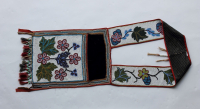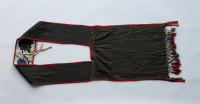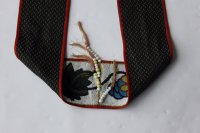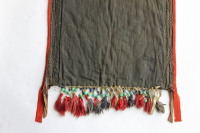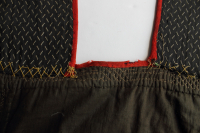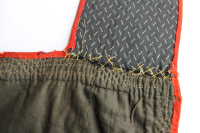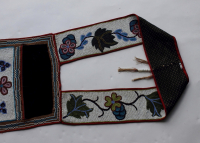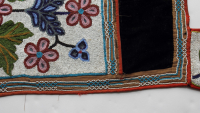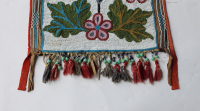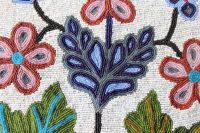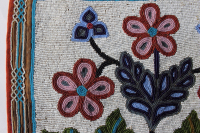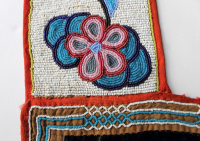Bandolier bag
Bandolier bag
Bandolier bag

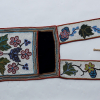
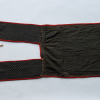
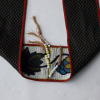
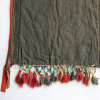
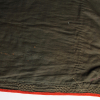
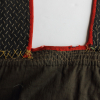

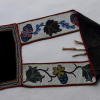
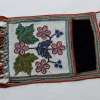
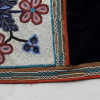
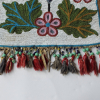
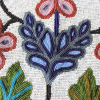

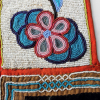
Bandolier, velvet, overlayed spot stitch beadwork on pouch panel & straps, symmetrical & asymmetrical beaded designs, fringe of wool tassels
from catalogue records
Read More About This Relative
Canvas, velvet, cotton, seed beads, wool tape, silk, wool, thread.
Rectangular pouch panel with two shoulder strap panels, Pouch front and shoulder panels are canvas, Pouch back is black velvet at top and dark green cloth at bottom, Brown cloth border along sides, Lining is cotton sack cloth with blue lettering and print for pouch front, dark green cloth for pouch back and brown patterned cloth for strap, Four fringes of large round beads at shoulder panel seam, each fringe has seven beads with loose threads creating a tassel at end.
Pouch front and shoulder panels completely covered with broad floral designs of multi-coloured semi-translucent and opaque beads in white background, Border is otter tracks in white and turquoise blue beads, All edges, except bottom edge, have red wool tape border, Bottom edge has series of hide or heavy cotton fringes of cylindrical round facetted beads with large round light green beads and blue or red wool tassels at ends, Outer two fringes are white, One inner fringe is white and yellow, other inner fringe is white, yellow with one black multi-facetted bead, Sewing done with cotton blend thread.
Bandolier bags most likely originated in the Upper Great Lakes region during the 1840s and 1850s. Fashioned exclusively from European materials and adorned with thousands of beads, bandolier bags were primarily for show, as a symbol of identity, wealth and status. Although initially functional, by the late 19th and early 20th centuries many of the bags had false pouches or none at all. Sometimes called "friendship bags", they were often created as gifts to strengthen relationships within communities or between nations. By the 1870s they had become an important element of formal dress worn mainly at ceremonies and celebrations by men, and occasionally by women. They wore them - singly or several at a time - crossed over the torso or draped around the neck. The wearing of more than one bag was generally the prerogative of a leader or a person of high honour." (McCord, 2013)
From catalogue records.
Provenance
Hudson's Bay Company Winnipeg Fur Trade Department collected materials in preparation for 250th anniversary celebrations of the HBC in 1920. Many of these items were used in the Processions and Pow Wow at Lower Fort Garry in May, 1920. [From catalogue records]. Acquired for the HBC Museum Collection in April 1922. One of 25,000 of artefacts from the original Hudson's Bay Company Museum Collection which was donated to the Manitoba Museum by the HBC in 1994.
Montreal: The McCord Museum, 2013; Print.
Hudson's Bay Company Historical Exhibit opened June 19, 1922, in Winnipeg in the Portage Avenue "HBC" store.
Originally in the collection of Mr. T.J. Fleetham. Mrs. A.W. Daggs (Fleetham's clerk) of Touchwood Hills, Saskatchewan acquired the collection from his estate. It was included in one of the artefacts acquired by the Manitoba Museum as part of the Hudson's Bay Company Museum Collection in 1994. [Based on catalogue records]
About This GRASAC Record
Manitoba Museum













Attributed to the Plains Geo-Cultural area
 Knowledge Sharing Platform
Knowledge Sharing Platform

